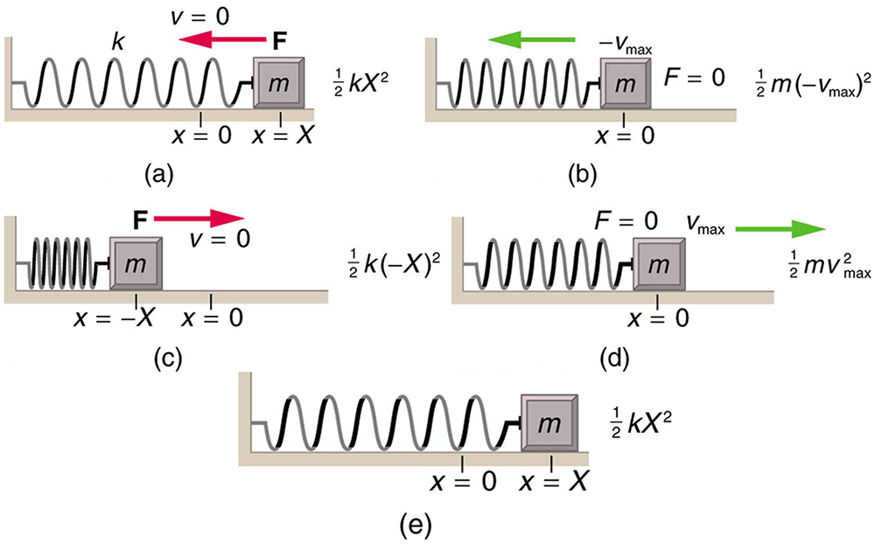Oscillatory Motion and Waves and Physics of Hearing.
120 Energy and the Simple Harmonic Oscillator
Learning Objectives
- Determine the maximum speed of an oscillating system.
To analyze the energy in a (SHM) system, we begin by identifying all the energy forms it can possess. From Hooke’s Law, we know that a stretched or compressed spring stores , expressed as:
In the absence of energy loss (e.g., no friction), total mechanical energy is conserved. That means the total of and potential energy remains constant:
Or, in terms of variables:
This applies to any SHM system, including pendulums. For a simple pendulum, we use the substitutions:
- Velocity: [latex]v = L\omega[/latex]
- Spring constant: [latex]k = \frac{mg}{L}[/latex]
- Displacement: [latex]x = L\theta[/latex]
This gives us an energy expression for pendulums:
In an undamped SHM system, energy oscillates between kinetic and potential forms. For example, in a spring-mass system on a frictionless surface, as illustrated in Figure 120.1, the energy shifts from entirely potential (stored in the spring) to entirely kinetic (when passing equilibrium), and back again.

We can derive the velocity of an object in SHM using conservation of energy. Suppose the object starts from rest at its maximum displacement [latex]x = X[/latex], then the total energy is:
At any point in the motion:
Solving for [latex]v[/latex], we get:
This can be rewritten as:
Or in terms of maximum velocity:
Where:
Maximum velocity occurs at the equilibrium position ([latex]x = 0[/latex]). This velocity depends on:
- Amplitude: Larger amplitude [latex]X[/latex] increases [latex]v_{\text{max}}[/latex].
- Spring stiffness: Greater spring constant [latex]k[/latex] leads to higher [latex]v_{\text{max}}[/latex].
- Mass: Heavier objects ([latex]m[/latex]) reduce [latex]v_{\text{max}}[/latex] because acceleration is lower.
For a simple pendulum, we can derive a similar expression using angular displacement:
This relates the pendulum’s angular velocity to its maximum angular displacement [latex]\theta_{\text{max}}[/latex], length [latex]L[/latex], and gravitational acceleration [latex]g[/latex].
Example 120.1: Determine the Maximum Speed of an Oscillating System: A Bumpy Road
Suppose that a car is 900 kg and has a suspension system that has a force constant [latex]k=6\text{.}\text{53}×{\text{10}}^{4}\phantom{\rule{0.25em}{0ex}}\text{N/m}[/latex]. The car hits a bump and bounces with an amplitude of 0.100 m. What is its maximum vertical velocity if you assume no damping occurs?
Strategy
We can use the expression for [latex]{v}_{\text{max}}[/latex] given in [latex]{v}_{\text{max}}=\sqrt{\frac{k}{m}}X[/latex] to determine the maximum vertical velocity. The variables [latex]m[/latex] and [latex]k[/latex] are given in the problem statement, and the maximum displacement [latex]X[/latex] is 0.100 m.
Solution
- Identify known.
- Substitute known values into [latex]{v}_{\text{max}}=\sqrt{\frac{k}{m}}X[/latex]:
[latex]{v}_{\text{max}}=\sqrt{\frac{6\text{.}\text{53}×{\text{10}}^{4}\phantom{\rule{0.25em}{0ex}}\text{N/m}}{\text{900}\phantom{\rule{0.25em}{0ex}}\text{kg}}}(0\text{.}\text{100}\phantom{\rule{0.25em}{0ex}}\text{m)}.[/latex]
- Calculate to find [latex]{v}_{\text{max}}\text{= 0.852 m/s}.[/latex]
Discussion
This answer seems reasonable for a bouncing car. There are other ways to use conservation of energy to find [latex]{v}_{\text{max}}[/latex]. We could use it directly, as was done in the example featured in Hooke’s Law: Stress and Strain Revisited.
The small vertical displacement [latex]y[/latex] of an oscillating simple pendulum, starting from its equilibrium position, is given as
where [latex]a[/latex] is the amplitude, [latex]\omega[/latex] is the angular velocity and [latex]t[/latex] is the time taken. Substituting [latex]\omega =\frac{2\pi }{T}[/latex], we have
Thus, the displacement of pendulum is a function of time as shown above.
Also the velocity of the pendulum is given by
so the motion of the pendulum is a function of time.
Check Your Understanding
Question 1: Why does it hurt more if your hand is snapped with a ruler than with a loose spring, even if the displacement of each system is equal?
Answer: The ruler is a stiffer system. A stiffer system has a higher spring constant [latex]k[/latex], which means it exerts more force for the same displacement. More force results in a greater impact, which causes more pain.
Question 2: You are observing a simple harmonic oscillator. Identify one way you could decrease the maximum velocity of the system.
Answer: You could increase the mass of the object. Since the maximum velocity is inversely related to the square root of the mass, a heavier object will oscillate more slowly.
Section Summary
- In a , energy is continuously exchanged between and , while the total mechanical energy remains constant:
[latex]\frac{1}{2}mv^2 + \frac{1}{2}kx^2 = \text{constant}[/latex]
- The maximum velocity of the oscillator depends on:
- Amplitude [latex]X[/latex] (larger amplitude means higher velocity),
- Spring constant [latex]k[/latex] (stiffer springs give higher force and speed),
- Mass [latex]m[/latex] (heavier masses move slower).
The maximum velocity is given by:
[latex]v_{\text{max}} = \sqrt{\frac{k}{m}}X[/latex]
Conceptual Questions
- Explain in terms of energy how dissipative forces such as friction reduce the amplitude of a harmonic oscillator. Also explain how a driving mechanism can compensate. (A pendulum clock is such a system.)
Problems & Exercises
- The length of nylon rope from which a mountain climber is suspended has a force constant of [latex]1\text{.}\text{40}×{\text{10}}^{4}\phantom{\rule{0.25em}{0ex}}\text{N/m}[/latex]. (a) What is the frequency at which he bounces, given his mass plus and the mass of his equipment are 90.0 kg? (b) How much would this rope stretch to break the climber’s fall if he free-falls 2.00 m before the rope runs out of slack? Hint: Use conservation of energy. (c) Repeat both parts of this problem in the situation where twice this length of nylon rope is used.
- Engineering Application Near the top of the Citigroup Center building in New York City, there is an object with mass of [latex]4\text{.}\text{00}×{\text{10}}^{5}\phantom{\rule{0.25em}{0ex}}\text{kg}[/latex] on springs that have adjustable force constants. Its function is to dampen wind-driven oscillations of the building by oscillating at the same frequency as the building is being driven—the driving force is transferred to the object, which oscillates instead of the entire building. (a) What effective force constant should the springs have to make the object oscillate with a period of 2.00 s? (b) What energy is stored in the springs for a 2.00-m displacement from equilibrium?

